Hoyas are fantastic houseplants with foliage that comes in many shapes, sizes, colors, and textures – in fact, there is so much variety that it can be hard to know which one to choose!
This guide will take you on a tour of 29 different varieties to choose from.
It will help you in your decision-making process, so you can pick the hoya (or three) that will bring you the most joy – and that will adapt well to your growing conditions.
We’ll have a look at where each of these species comes from, but more importantly, what they look like – including leaf color, texture, and pattern, as well as flower colors.
And since there are some identity crises amongst the hoyas, we’ll try to get to the bottom of a few of those as well, sorting out which varieties may sometimes be confused for each other or referred to by multiple names.
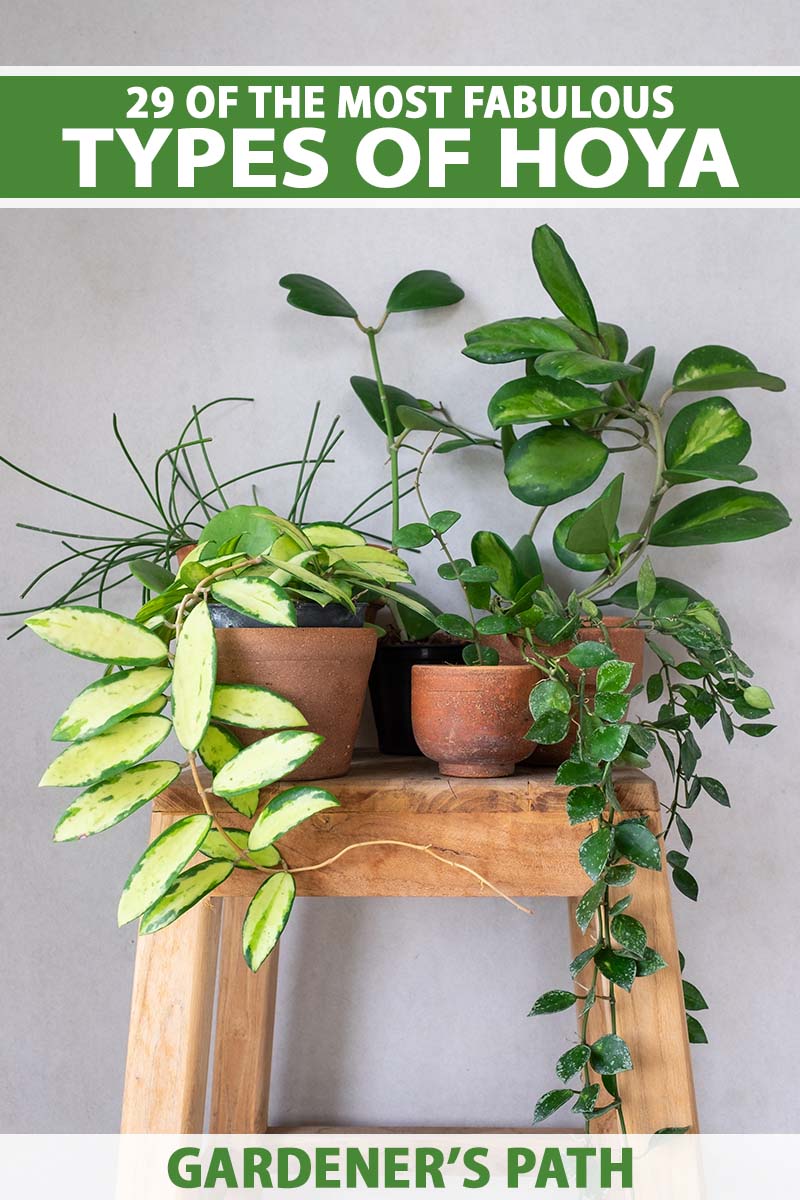
We link to vendors to help you find relevant products. If you buy from one of our links, we may earn a commission.
Whether you’re interested in purchasing just one of these houseplants, thinking of starting a hoya collection, or planning to expand the collection you already have, this guide will help you deepen your understanding, love, and appreciation for these beautiful plants.
Ready to get started on our hoya tour? Here’s a sneak peek at the stops along the way:
While this article will provide some care tips for certain species that tend to have slightly different needs than average, you can brush up on your basics by reading our complete guide to growing and caring for hoyas.
1. Albomarginata
H. kerrii var. albomarginata has large, succulent leaves that are shaped like hearts. These are green with creamy yellow margins.
Sometimes labeled H. kerrii ‘Variegata,’ this is a variegated naturally occurring variety of H. kerrii.
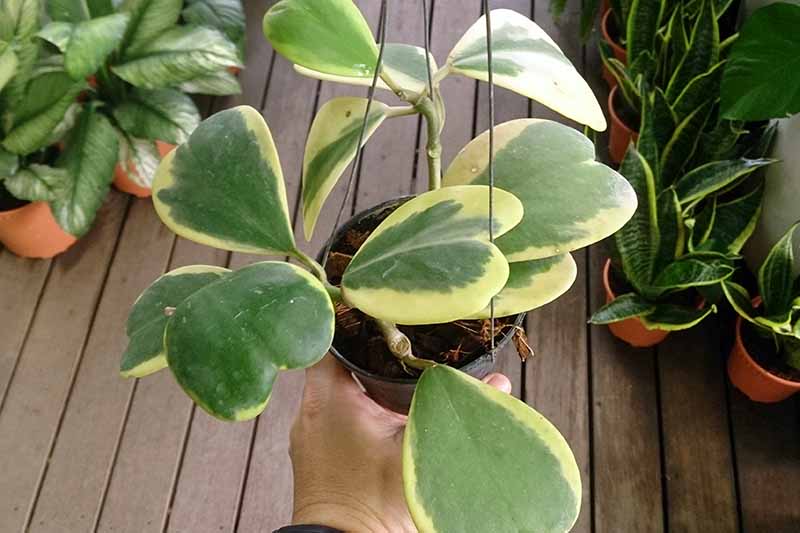
Variegated waxhearts plants have white flowers with russet centers, and vines that can eventually reach 13 feet long.
You can learn more about caring for sweetheart hoya in our growing guide.
The first thing you need to know is that this slow-growing species and the available varieties are priced based on the number of leaves on the plant – with the most inexpensive specimens being just a single rooted leaf.
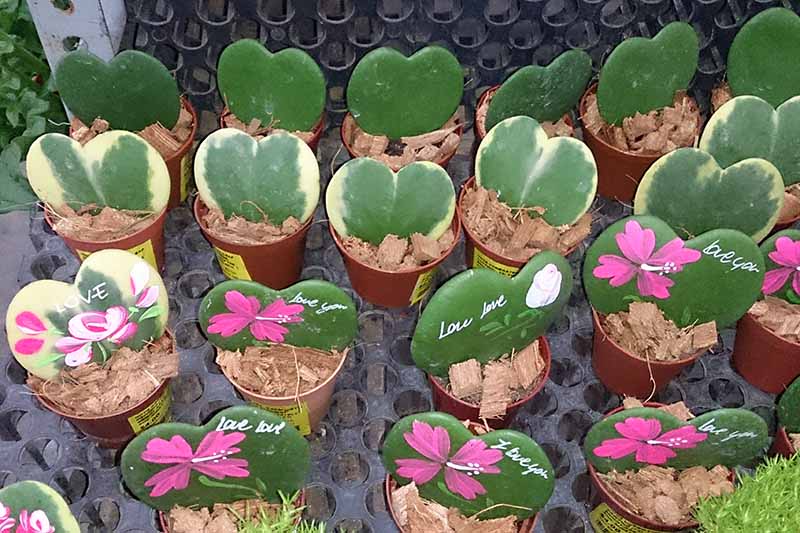
However, when choosing a specimen to purchase, while they are cute, be aware that sweetheart hoyas with only one heart-shaped leaf in the pot sometimes fail to ever mature into vining plants.
If you want a specimen that will grow to its full size, make sure to purchase a sweetheart hoya that was rooted with at least one node, or in other words, choose a specimen with at least two leaves.

H. Kerri Albomarginata Live Plant
You’ll find a live variegated waxhearts plant with at least three leaves in a four-inch pot available from California Tropicals via Amazon.
2. Australis
H. australis is a fast-growing, easy-care hoya that makes an excellent choice for beginners.
This top pick is native to Australia, as well as Borneo, Fiji, New Guinea, Samoa, the Solomon Islands, Tonga, Vanuatu, and the Wallis-Futuna Islands.
Its species name, australis, doesn’t mean “from Australia” as you might have guessed, but is a Latin term meaning “from the south.”
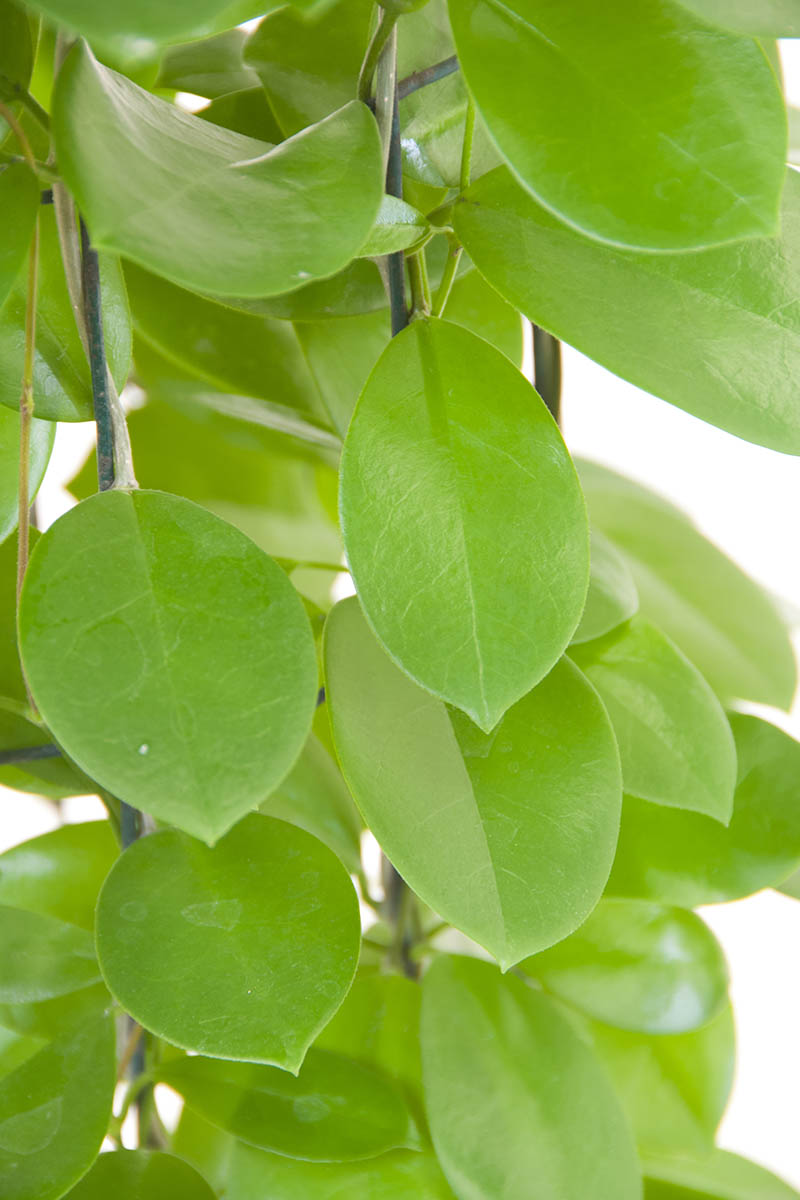
Also called “New South Wales wax flower,” H. australis has light to medium green leaves that are broad and oval-shaped or elliptical. New growth has a lovely reddish hue.
There are many gorgeous subspecies and cultivars of this plant, but the natural species is pretty in its own right.
With vines that can reach eight feet long or more, H. australis has fragrant white bunches of flowers with reddish centers that bloom in fall and winter.
Grown outdoors, this species is hardy in USDA Hardiness Zones 10a and 11.
H. Australis Live Plant in 4” Pot
Interested in creating space for H. australis? You’ll find one in a four-inch pot from Hirt’s Gardens via Walmart.
3. Bella
I would argue that all hoyas are beautiful, but this pick in our roundup actually has beauty in its name: H. lanceolata ssp. bella, also known as “beautiful hoya.”
Native to Assam, India, and Myanmar, you may sometimes see it labeled as its own species, H. bella. Barring any potential confusion, this is the same plant.
With light green leaves that are shaped like arrowheads, these are on the small side, measuring up to one inch in length.
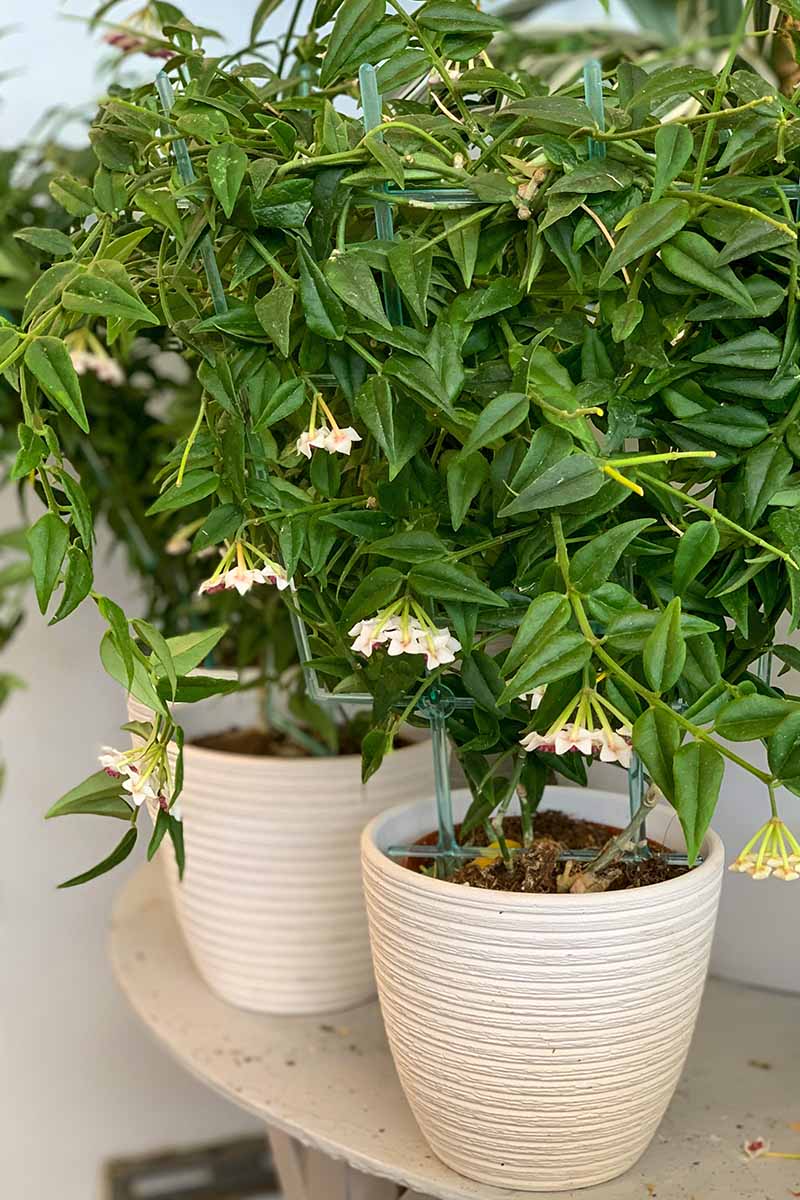
The flowers are white with pinkish-purple centers, and they hang delicately from short vines. Unlike most hoyas you will encounter as houseplants, this type drops its peduncles after flowering.
Also called “miniature wax plant,” this compact variety grows to just one and a half feet wide and tall, and has a shrubbier growth habit than many other hoyas.
Bella does not like to grow in soil that has been allowed to dry out all the way, and it can tolerate more direct sun than many hoyas.
If you want to bring this beautiful hoya home, you’ll find plants available in four-inch pots from Wayfair.
4. Bilobata
Native to the Philippines, H. bilobata has small to medium-sized, elliptical, grayish-green leaves. The leaves are smooth and have a matte look, with a noticeable lighter-colored central vein.
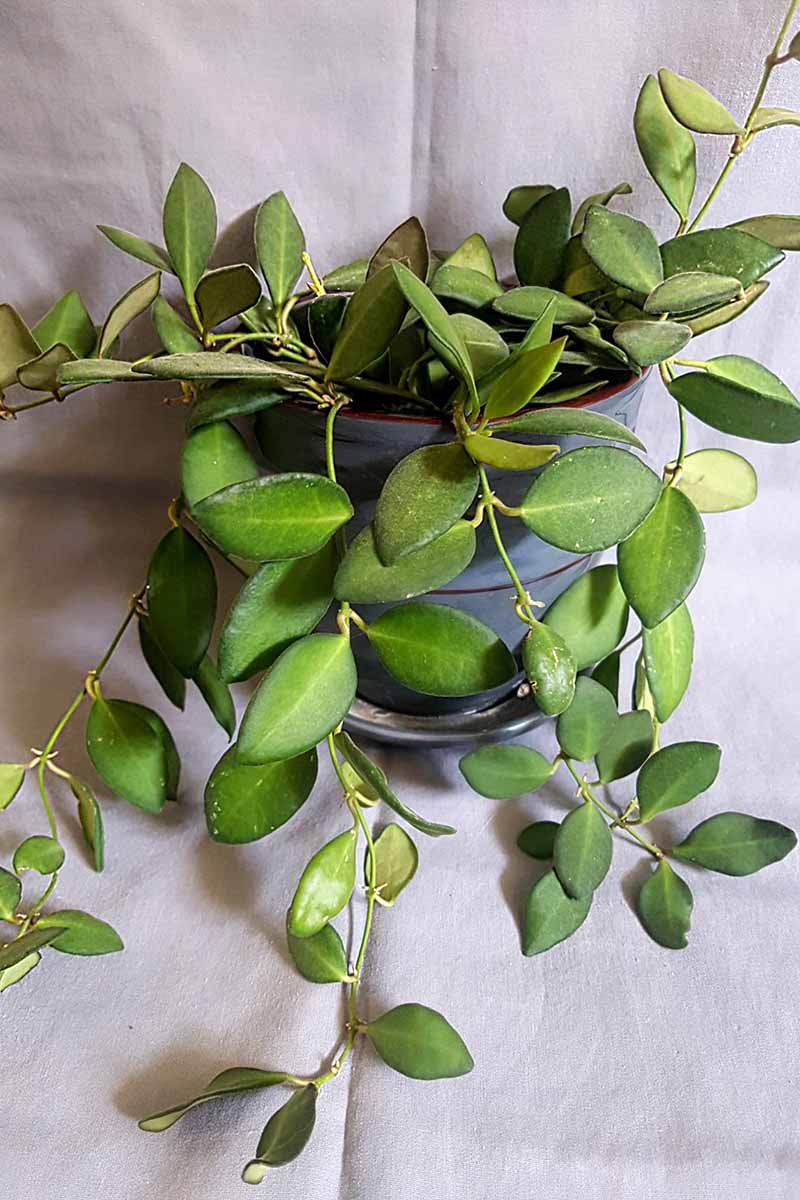
Inflorescences are small, about the size of a quarter, and the flowers are dusty pink with yellow centers.
One of the smaller species of trailing and climbing hoyas, the vines of this type tend to reach only about two feet long.
H. bilobata prefers bright, indirect light and temperatures between 60 and 95°F.
This species bears a very strong resemblance to, and is also often confused for, an unnamed species known currently as H. sp. aff. burtoniae, based on its affinity to the named species. As such, H. burtoniae also looks very similar.
When comparing the two, H. bilobata has rounder, smoother leaves, while H. sp. aff. burtoniae has fuzzier and more elongated leaves.
If you’re not confused enough yet, H. sp. aff. burtoniae, a species with more widespread commercial availability, is often erroneously identified as H. bilobata.
Long story short – feel the foliage. If it’s fuzzy, the specimen is not H. bilobata.
5. Callistophylla
Let’s leave behind those confusing lookalikes for now and move on to a seriously striking hoya – this next selection is quite a knockout.
H. callistophylla has large, leathery leaves that are light green, patterned with contrasting darker green veins. These leaves can reach over nine inches long and three and a half inches wide.

The species name callistophylla comes from the Greek words kallisto and phylum, which mean “most beautiful leaf” in combination. (Watch out H. bella, H. callistophylla is giving you a run for your money!)
A tropical species native to Borneo, this hoya likes slightly cooler, humid conditions, and its vines can reach six to 12 feet long – or more.
The flowers have white star-shaped coronas with red and yellow corollas in the background. These are mildly fragrant, with each one lasting just a day.

H. callistophylla Live Plant in 4” Pot
You can find H. callistophylla available in four-inch pots from The Plant Farm Store via Amazon.
Keep this species away from curious kids and pets – it may be toxic if ingested.
6. Chelsea
‘Chelsea’ is one of many enticing cultivars of H. carnosa, a species that’s native to eastern Asia.
This cultivar has thick, medium-green leaves that are slightly cupped and rounded with pointed tips, making them almost heart-shaped.
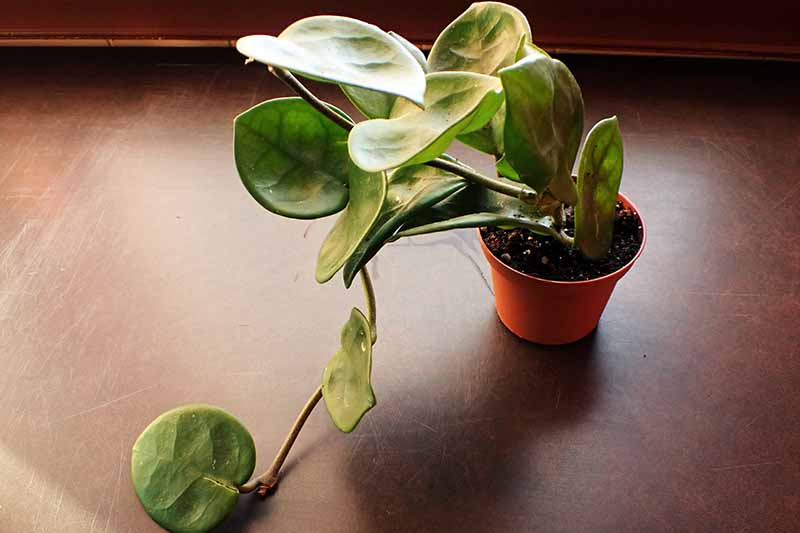
The inflorescences of ‘Chelsea’ bloom from late spring to summer and are large and rounded, bearing pale pink flowers with red centers. Its vines can grow to be six feet long, or sometimes more.
The thick foliage of this hoya indicates increased drought tolerance, and it prefers to dry out fairly thoroughly between waterings.
Outdoors, this cultivar is cold hardy in Zones 9b to 11, but in colder zones, it should be brought indoors in the fall.
Like the species plant and its other cultivars, ‘Chelsea’ is considered nontoxic to dogs and cats.

H. Carnosa ‘Chelsea’ Live Plant in 6” Pot
Does the succulent, heart-shaped foliage of ‘Chelsea’ make your own heart leap? You’ll find this houseplant available for purchase in a four- or six-inch pot via Amazon.
7. Curtisii
Our next selection has mottled foliage, but I don’t think this species will garner divided opinions like ‘Sumatra,’ which we’ll get to later in the roundup.
H. curtisii has leaves that are light to olive green with silver mottling, and they have a somewhat rough texture, like reptile skin.
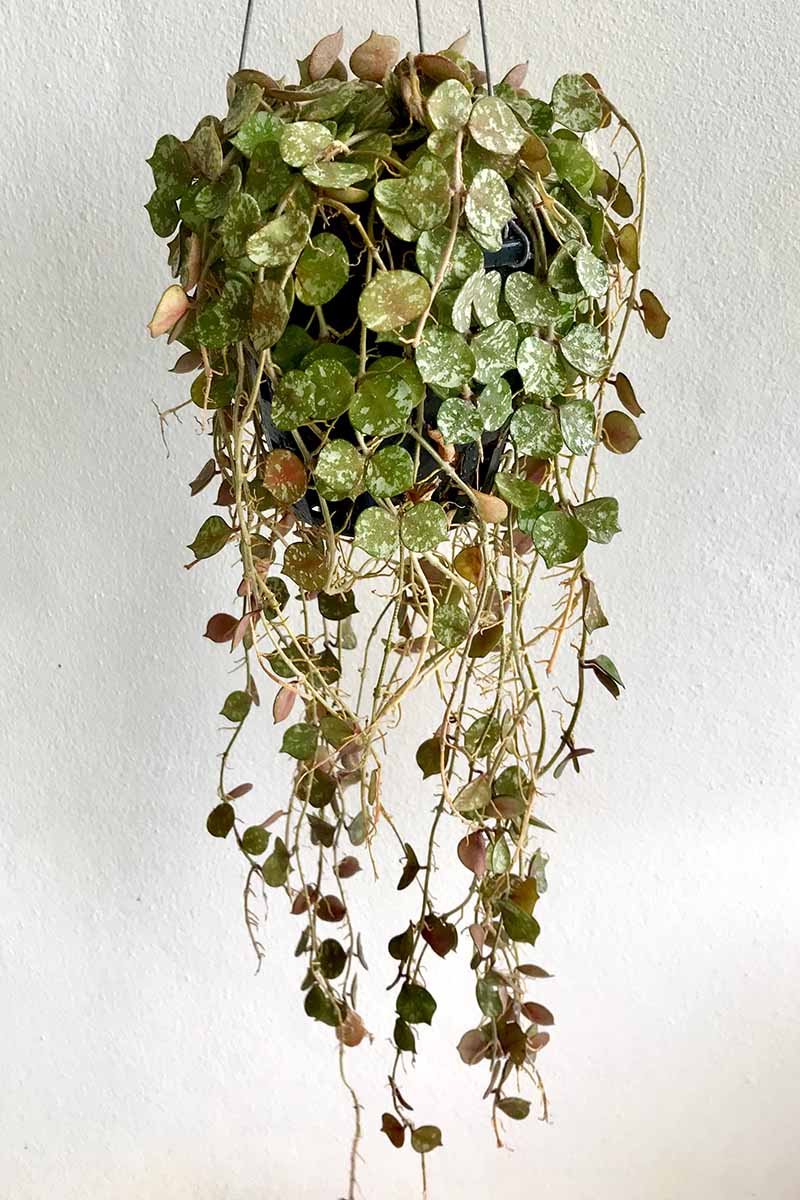
The leaves are small, just half an inch across, and they have a unique shape – round with pointed ends that remind me of Christmas tree baubles.
The green colors in this species’ foliage will turn to red or maroon when exposed to brighter light.
Native to Borneo, Malaysia, the Philippines, and Thailand, this species has a creeping growth habit, creating a dense mat of vines that will grow to be one and a half to three feet long.
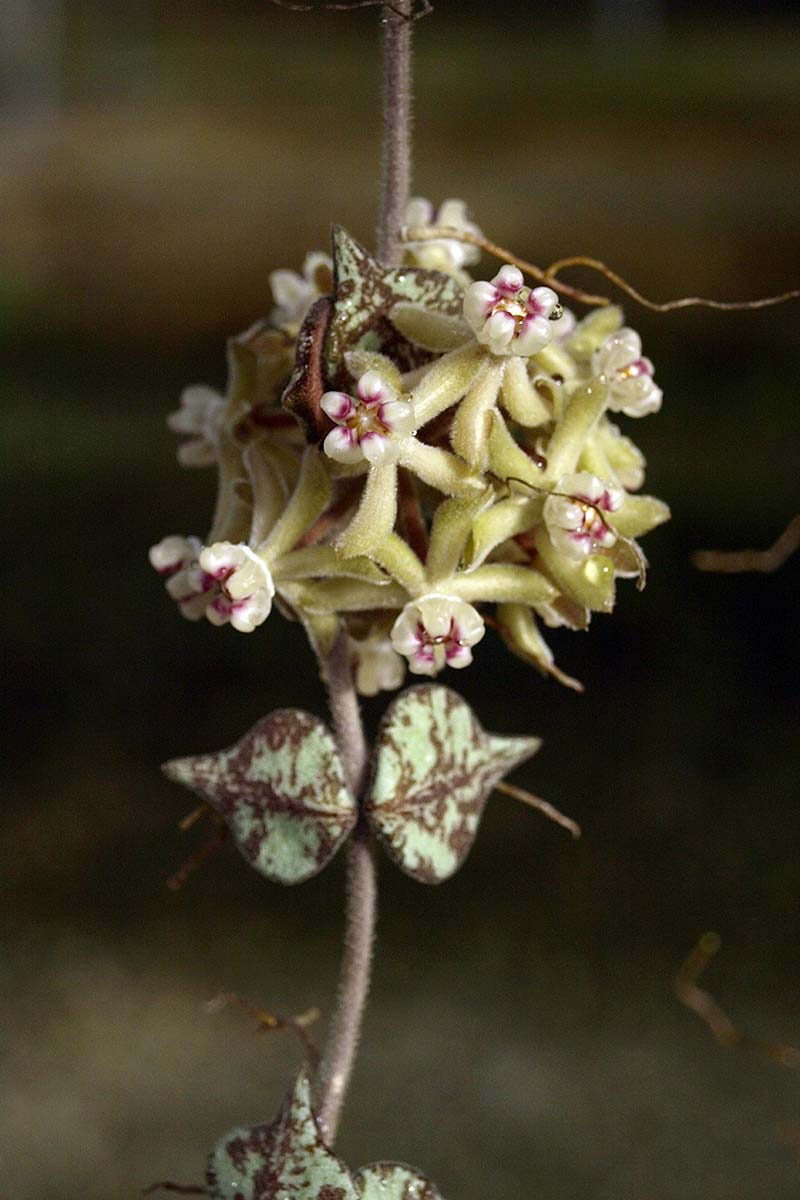
Also called “Aloha wax plant,” the flowers of H. curtisii are reflexed at maturity, cream colored with red to orange centers and a velvety texture.
H. curtisii prefers slightly cooler conditions than some other hoyas, so you will probably not want to let this one spend its summers outdoors in hotter climates.

H. Curtisii Live Plant in 6” Pot
Want to welcome this wax plant with a hearty “aloha”? You’ll find live H. curtisii specimens in six-inch pots from California Tropicals via Amazon.
8. Diversifolia
H. diversifolia is a tropical species native to the coastal forests of Myanmar, Vietnam, Thailand, Cambodia, Sumatra, Malaysia, Singapore, Borneo, Java, and the Philippines.
Its leaves are thick and oval-shaped or elliptical, and they can grow to be five inches long by two and a half inches wide.
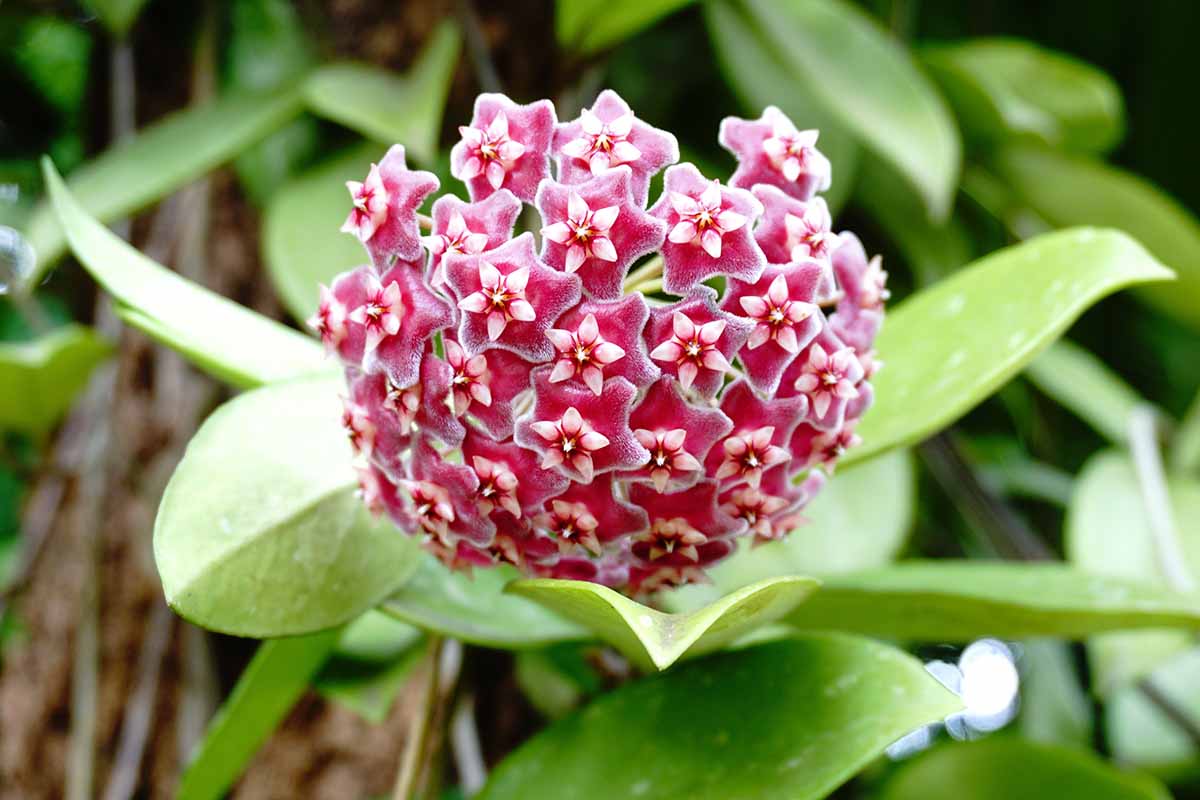
The vines can reach eight feet long or more, and these plants produce flowers that are creamy pale pink with darker pink centers, lasting for several days.
This species is quite adaptable to different growing conditions, and it is used ethnobotanically in Malaysia.
In some of its native habitat it is critically endangered, so purchase this one only from responsible vendors.
9. Elliptica
This next species is native to Malaysia, Thailand, and the Philippines, and with its prominent leaf veins, it bears a resemblance to the aforementioned H. callistophylla.
But while that species has light green leaves with dark veins, H. elliptica has white veins on its elliptical green leaves, which create a prominent tortoiseshell pattern.
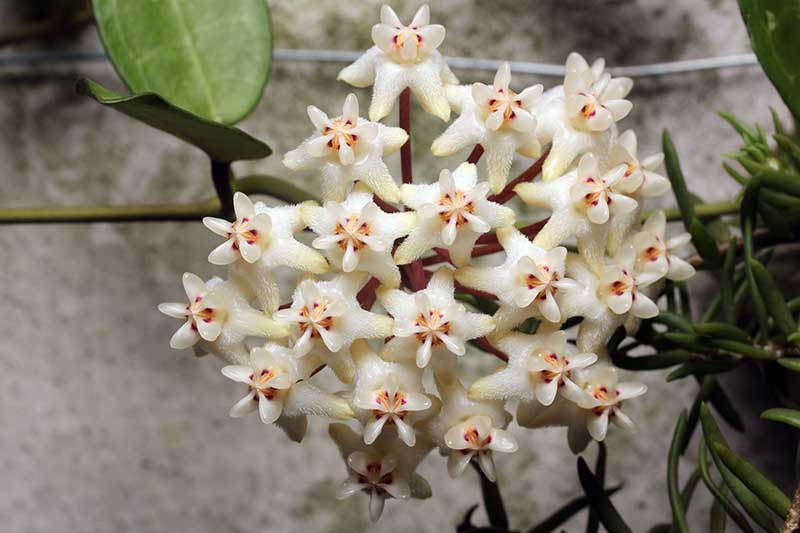
The flowers are white with a pink tinge, and they have reddish centers.
This species is a bit fussy, so hoya newbies, beware! It likes high humidity and medium, indirect light. It will grow best in a greenhouse or a similar high-humidity situation.

H. Elliptica Live Plant in 6” Pot
Do these tortoiseshell-patterned leaves strike your fancy? You’ll find H. elliptica available in a six-inch pot from California Tropicals via Amazon.
10. Kentiana
Also called “narrowleaf hoya,” H. kentiana is native to the Philippines and has long, narrow green leaves with dark green edges, growing on vines that can reach eight feet long or more.
With bright light or some direct sun, the edges of the leaves will develop a reddish color.
The maroon flowers with yellow centers bloom between late spring and early fall. They last for a week, and are said to smell like butterscotch.

H. Kentiana Live Plant in 4” Pot
If this species sounds like it will make an exciting addition to your hoya collection, you’ll find a live specimen in a four-inch pot available from the BubbleBlooms store via Amazon.
11. Krinkle 8
This cultivar of H. carnosa looks similar to ‘Chelsea’ but its leaves are longer, and oval-shaped rather than round.
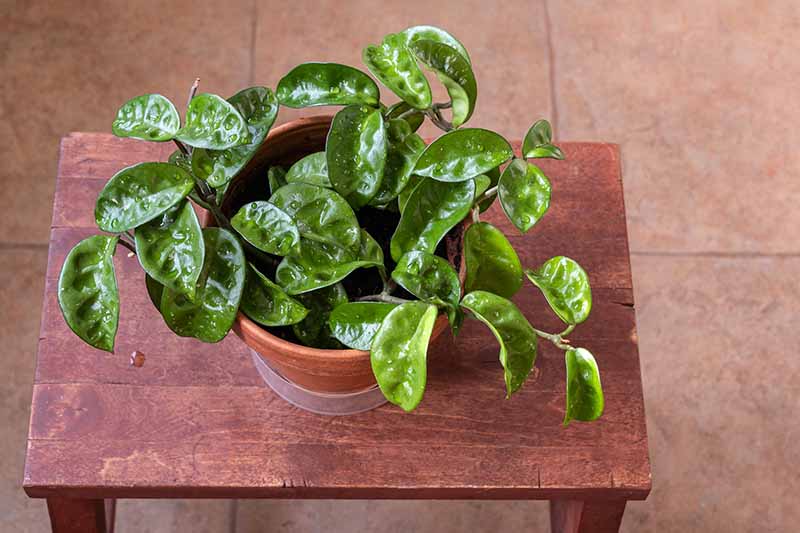
The leaf tips are rounded or very slightly pointed, and the leaves are indented, reminding me of the inside of a pea pod.
The flowers of this variety are pale pink with red centers, on vines that reach six feet long or more.

H. Carnosa ‘Krinkle 8’ Live Plant in 6” Pot
If you like a plant with a lot of texture, you might just love ‘Krinkle 8.’ You can purchase it in a six-inch pot from California Tropicals via Amazon.
12. Linearis
If you thought hoyas were all about big, thick, wide leaves, H. linearis will change your preconceived notions. This selection has quite narrow leaves that are long, thin, and slightly fuzzy, with pointed ends.
H. linearis grows wild in tropical and subtropical, high-elevation regions of China, Laos, Myanmar, Vietnam, Nepal, and India, including the Himalayas.
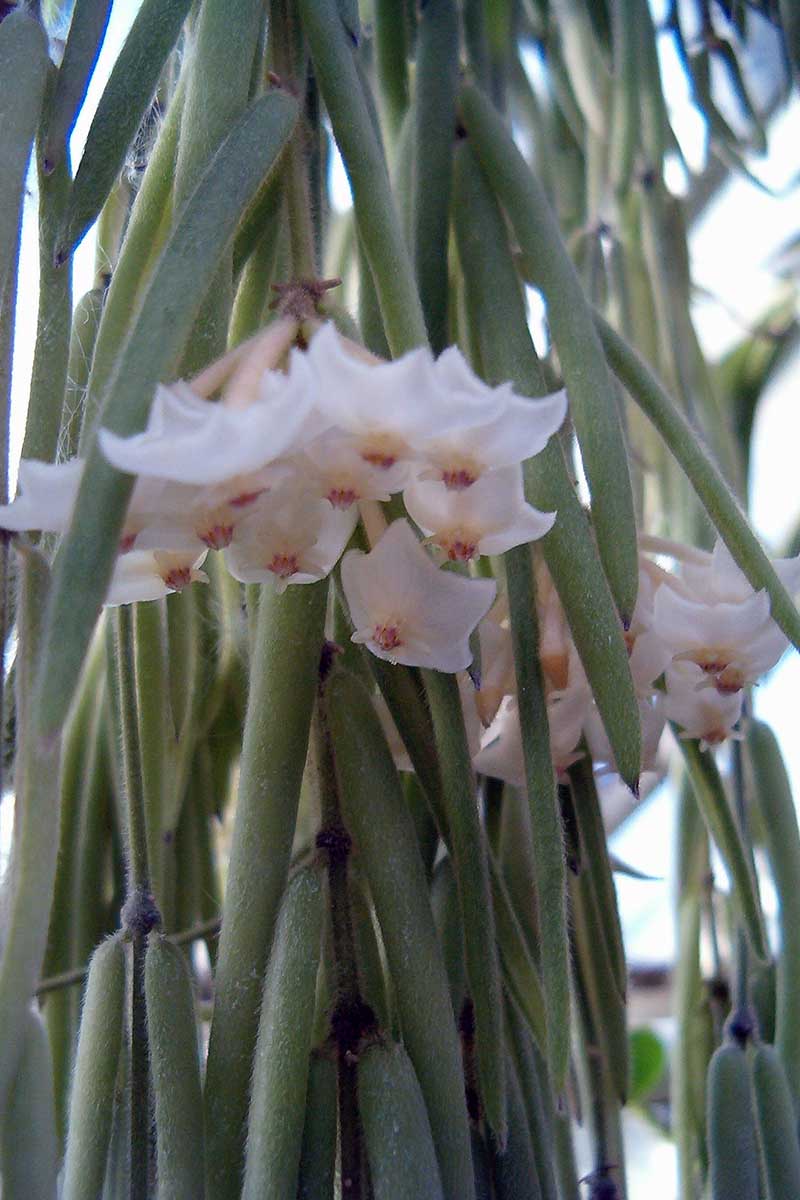
Mature plants in hanging baskets make quite the impact as the foliage takes on a delicate, wispy appearance.
The vines can grow to be six feet long or more, producing pendant clusters of white flowers with yellow and red centers that have a citrusy fragrance.
This hoya likes slightly cooler growing conditions, so don’t let it spend time outdoors when the weather is hot.
13. Lisa
‘Lisa’ is a cultivar of H. australis. While this variety shares many of the characteristics of the species, such as care requirements, bloom type, and vine length, this beauty has variegated foliage.
The leaves of ‘Lisa’ are oval or elliptical, and delicately variegated with various shades of green along the edges, transitioning to creamy tones at the center.
Each leaf is different, and looks as if it’s been painted with watercolors. New foliage emerges in pinkish tones.
H. Australis ‘Lisa’ Live Plant in 2” Pot
Is ‘Lisa’ calling your name? You can purchase a live starter plant in a two-inch pot from Hirt’s Gardens via Walmart.
14. Mathilde
How about an extra dose of texture in your hoya? ‘Mathilde’ has thick, succulent foliage covered with small hairs that give it a velvety texture. The flowers and stems of this variety are also slightly fuzzy.

This cultivar is an interspecies hybrid created by crossing H. carnosa and H. serpens. Its foliage is dark green with silver flecks and its thick, succulent leaves are oval shaped, and very slightly pointed.
The flowers of ‘Mathilde’ are white with reddish centers, and the vines grow to six feet long or more.

H. ‘Mathilde’ Live Plant in 2” Pot
The sight of ‘Mathilde’ just might put you in the mood for a waltz – or at least a happy dance! If so, you can purchase a live plant in a two-inch pot from the Plant Farm Store via Amazon.
15. Mindorensis
H. mindorensis has elliptical leaves that are glossy, with a medium green hue – but this is a hoya you’ll want to grow for its fantastic flowers.
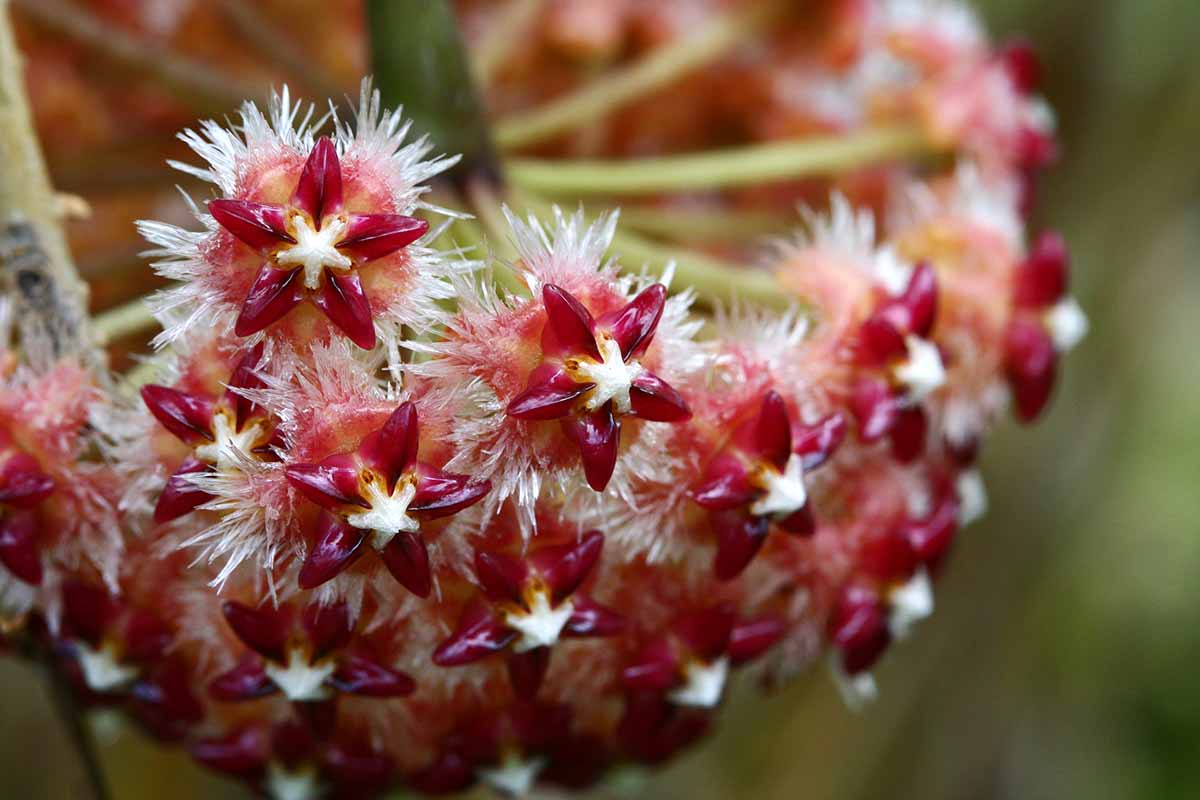
This tropical species is native to Borneo and the Philippines, and its species name, mindorensis, means “from Mindoro Island.”
The fragrant flowers grow in dense umbels and these can be dark red, reddish pink, or yellow, edged in frilly white hairs. The vines grow to be four to six feet long, or sometimes more.

H. Mindorensis Live Plant in 6” Pot
Want to add this beauty from Mindoro to your collection? You’ll find a live specimen with pink flowers in a six-inch pot from the Plant Farm Store via Amazon.
16. Multiflora
Our next selection has a different growth habit than most of the other hoyas we’ve met so far. H. multiflora is a trailing shrub with a bushy growth habit whose species name means “many flowered.”
This species has elliptical, medium to dark green leaves that can grow up to eight inches long and two and a half inches wide.
H. multiflora is a tropical, terrestrial species that is native to Bangladesh, Borneo, Cambodia, China, India, Indonesia, Laos, Malaysia, Myanmar, New Guinea, Philippines, Thailand, and Vietnam.
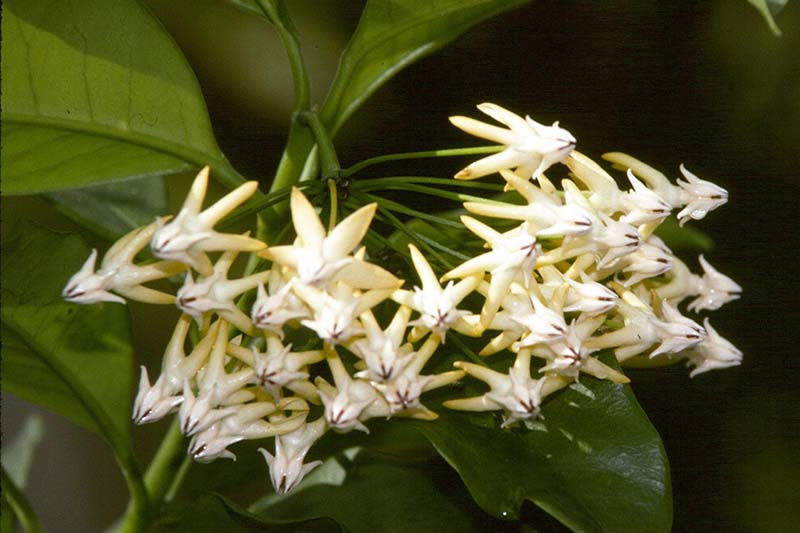
One of this hoya’s common names, “shooting stars,” comes from the shape of its flowers, which have reflexed corollas. The blooms are cream and gold with a sweet fragrance.
Though it will rarely grow so large indoors, the stems of H. multiflora can reach up to eight feet long. This hoya needs indirect medium or bright light.
This species doesn’t like to dry out quite as much as some of the others, so don’t let its soil become bone dry between waterings.
You might also consider providing it with a more water-retentive potting medium than what you use for your other hoyas – as long as the drainage is still excellent.

H. Multiflora Live Plant in 4” Pot
If you’d like to invite the shrubby H. multiflora into your home, you can purchase one in a four-inch pot from California Tropicals via Amazon.
17. Obovata
Growing hoyas for their flowers is certainly a noble pursuit, but let’s face it – most of us are entranced by their foliage and this next selection has such loveable leaves!
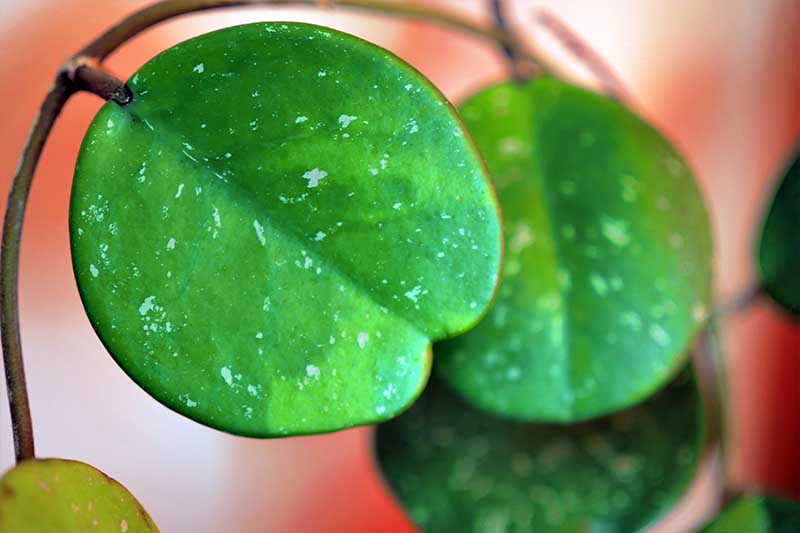
H. obovata is native to Indonesia, Thailand, and Vietnam, and has large, glossy, oval-shaped dark green foliage that often has a light “splash” pattern of silver and pink flecks.
The leaves are approximately three inches long by nearly three inches wide, and their shape inspired this plant’s species name, obovata.
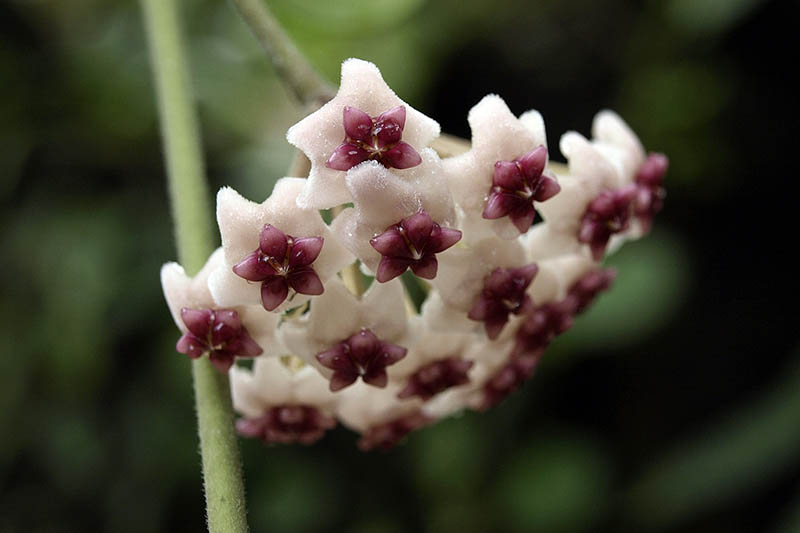
The vines can grow to eight feet long or more, and plants produce long-lived flowers that are pale pink with magenta centers.
This epiphytic species is hardy in Zones 9b to 12. Indoors, it should be placed in bright, indirect light to encourage its “splash” pattern.

H. Obovata Live Plant in 6” Pot
If H. obovata seems like the obvious choice, you can find live plants available for purchase in six-inch pots from California Tropicals via Amazon.
18. Pachyclada
H. pachyclada is native to tropical and subtropical habitats in Cambodia, Laos, Thailand, and Vietnam.
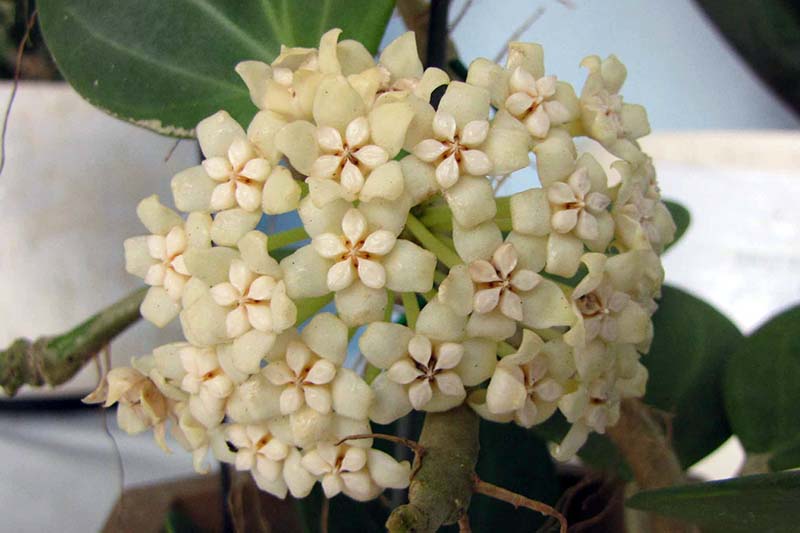
Thick, oval-shaped leaves are grayish-green with contrasting lighter-colored veins, and these can grow up to four inches long by two inches wide.
This slow-growing species has fragrant flowers that are creamy yellow and white, with a strong fragrance.
With quite succulent foliage, this hoya does well drying out between waterings.
If you find this thick-leaved hoya with yellow flowers appealing, you can purchase a live plant in a two-inch pot from Hirt’s Gardens via Walmart.
19. Rebecca
‘Rebecca’ is a hoya that’s particularly easy to love. It has colorful foliage, adorable flowers, and a fascinating origin story.
An interspecies cross, ‘Rebecca’ is a natural hybrid that occurred in 2007 or 2008 in the now defunct nursery of plant breeder and nurseryman Antone Jones between specimens of H. sp. aff. lacunosa from Langkawi Island and H. obscura. This cross was selected by Mr. Jones, but initiated by a pollinator.
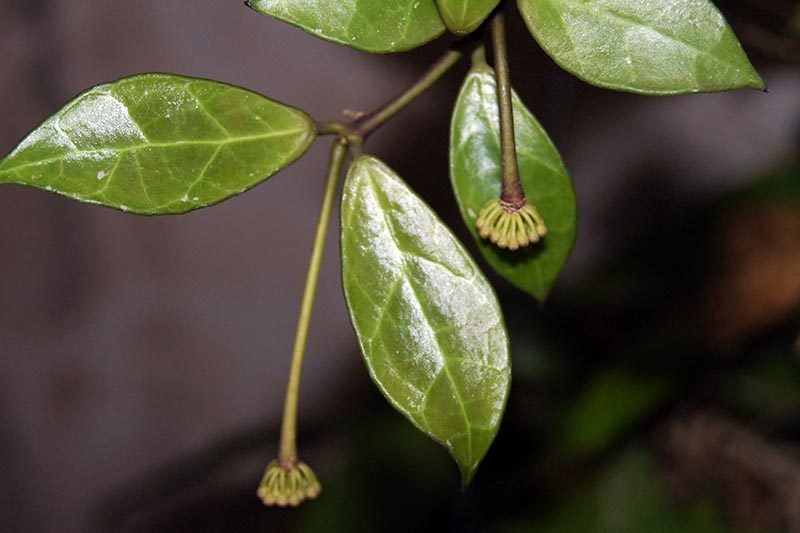
‘Rebecca’ has elliptical leaves with prominent veining, and will take on a reddish hue in bright light.
Fragrant inflorescences are small, with fuzzy pink flowers that have yellow coronas – and to me, these look like beautifully decorated little cupcakes.
The vines of this hybrid can reach six to eight feet long, or more.
‘Rebecca’ Live Plant in 4” Pot
If you find ‘Rebecca’ irresistible, you can purchase this interspecies cross in a four-inch pot from the Plant Farm Store via Amazon.
20. Retusa
You might want to classify our next selection, H. retusa, under the header “weird and wonderful flora.”
Native to India and the eastern Himalayas, this unusual species is also called “grass-leaved hoya.” It has long, thin, green leaves with blunt ends, giving the species a wispy appearance. Its foliage grows in clusters.
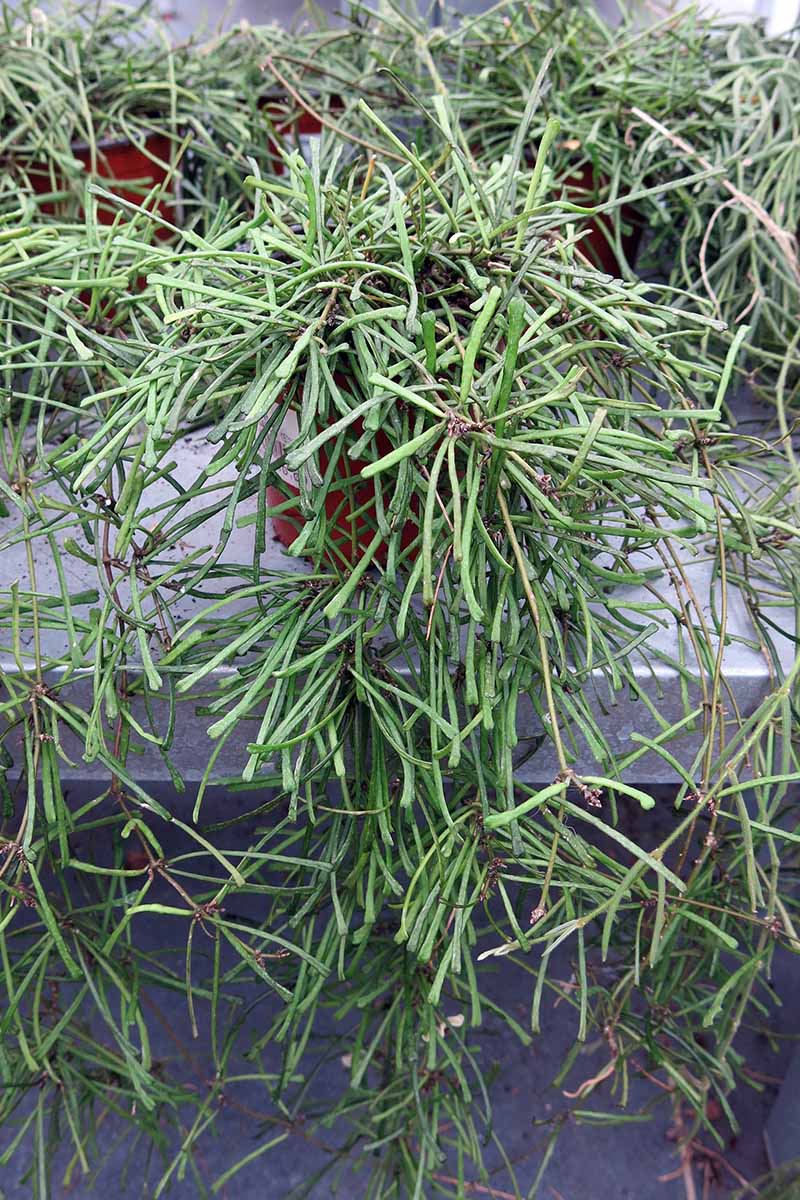
Differing from the wispy foliage of H. linearis mentioned above, the tips of the leaves widen at the ends and they are slightly indented.
This species is also sometimes called “frog toe wax plant.”
Vines grow to two feet long or more, and in the summer, the plants produce flowers that appear individually rather than in clusters. These are white with purple centers.

You can find H. retusa plants in four-inch pots available from the Bubbleblooms store via Amazon.
21. Rubra
Showcasing the amount of genetic diversity that is contained in a single species, ‘Rubra’ is another cultivar of H. carnosa, one that looks nothing at all like ‘Chelsea’ or ‘Krinkle 8.’
This variety has variegated, lance-shaped leaves with creamy white leaf centers and green margins. Vines and new foliage are often bright pink, giving it one of its other names, ‘Krimson Princess,’ sometimes incorrectly spelled ‘Crimson Princess.’
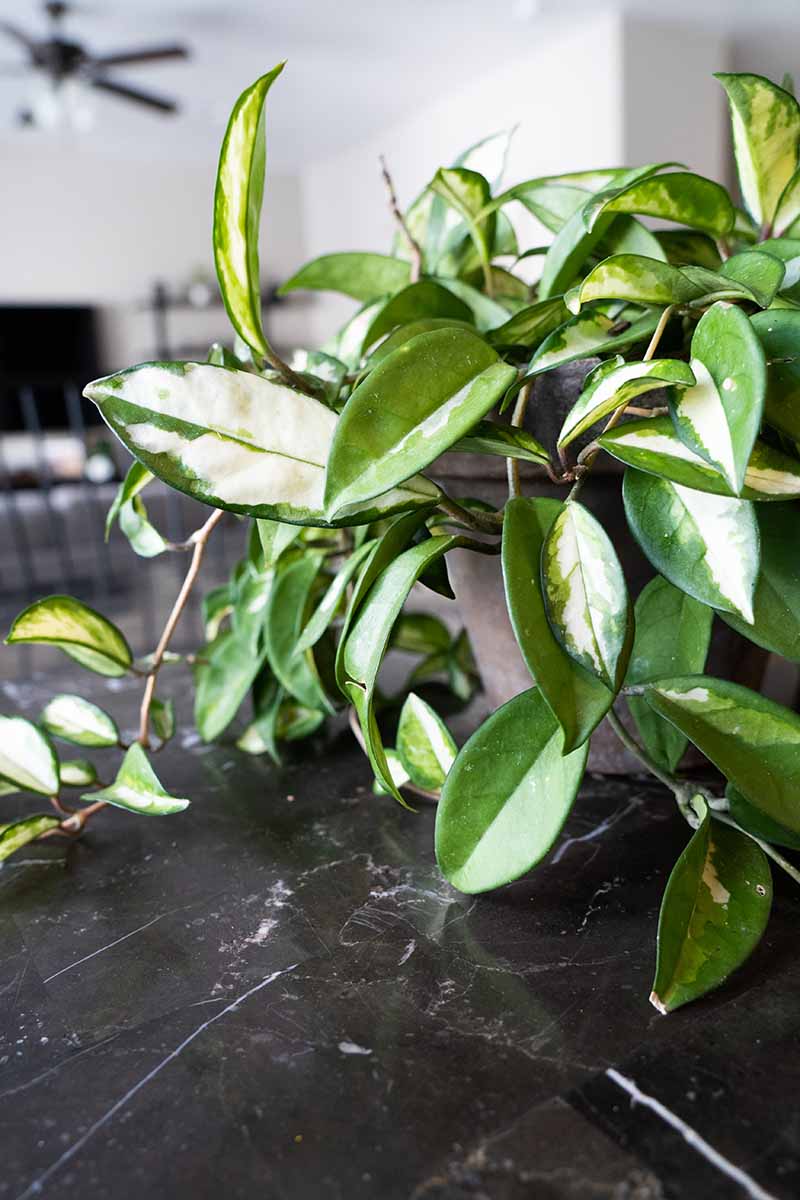
‘Rubra’ produces six-foot vines and bears large, dome-like inflorescences of fragrant, pale pink flowers with red centers.
These houseplants will revert to green without sufficient light. Make sure to provide this and other variegated cultivars with bright light, or they may lose their variegation.
H. Carnosa ‘Krimson Princess’ Live Plant
Call it what you want – ‘Rubra’ or ‘Krimson Princess.’ Either way, this hoya will provide mounds of lovely, variegated foliage. You’ll find this cultivar available in a four-inch pot from California Tropicals via Amazon.
22. Shepherdii
Also known as “string bean hoya,” H. shepherdii has long and narrow dark green leaves that look very much like green beans, and are three and a half inches long. Mature plants with long vines have particularly stunning foliage.

This species has a somewhat smaller native range compared to some of the others on this list, native only to Assam, India, and the East Himalayas.
The flowers are white with red centers, forming in small clusters. I think they look like they are sculpted out of icing and belong on top of a cake – but note that these are not edible!

You can find a string bean hoya with three to five leaves available for purchase from Amazon.
23. Silver
‘Silver’ is an H. krohniana cultivar that brings together visual interest and compelling textures.
The foliage of the species plant is green with delicate silvery gray splashes on heart-shaped, oval, or elliptical leaves that are pointed at the tips.
Native to the Philippines, it has leaves that are leathery with raised veins. These grow up to one and a half inches long by three-quarters of an inch wide.
The vines can reach eight feet long or more, and bear fragrant flowers that look like white puffballs with creamy yellow centers.
‘Silver’ has foliage that is even more heavily flecked with green, cream, and silvery gray splashes.

H. Krohniana ‘Silver’ Live Plant in 6” Pot
If the fuzzy flowers and splashy foliage of ‘Silver’ have caught your eye, you can find this rare cultivar in a six-inch pot from the Plant Farm Store via Amazon.
24. Splash
‘Splash’ is a cultivated variety of H. pubicalyx, a tropical species native to the Philippines.
The natural species has medium to dark green foliage adorned with flecks of silvery gray, while this cultivar has more dense splashes of silvery gray.
The leaves are long, pointed ovals, three inches long by one and a third inches wide.
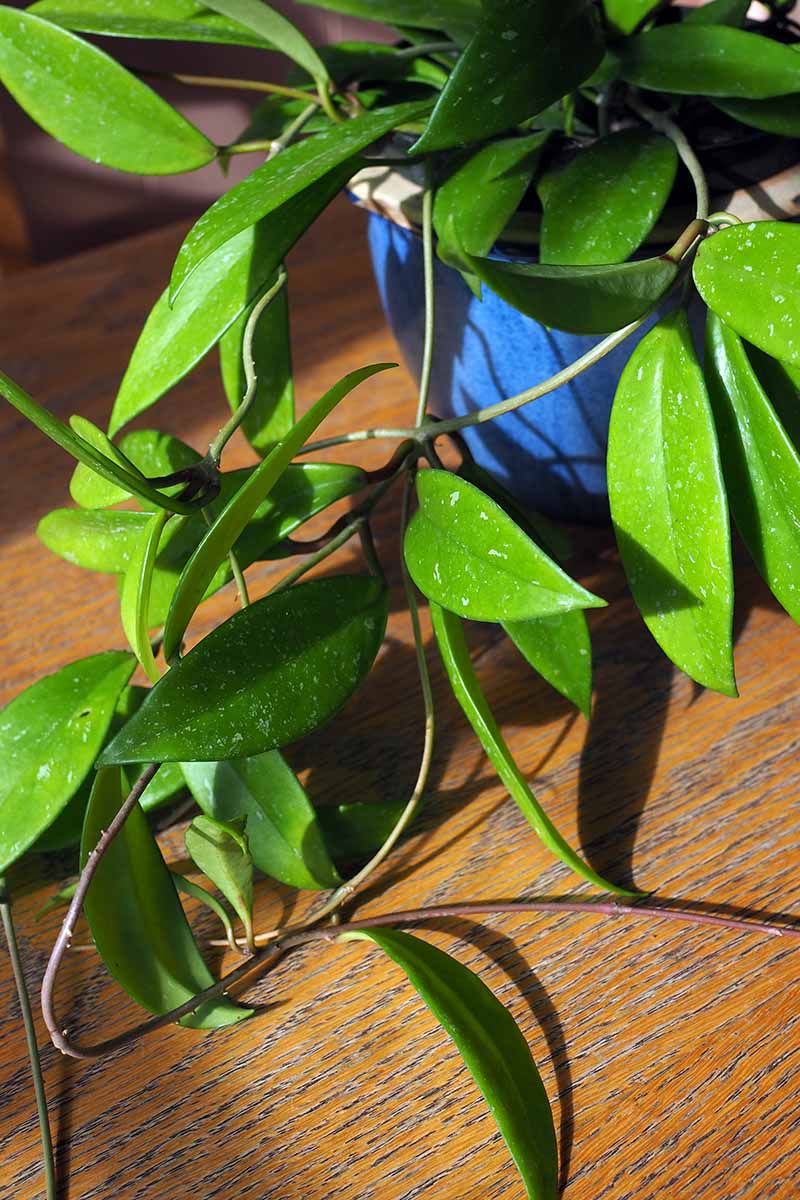
The vines of this hoya can grow to be 10 feet long or more.
H. pubicalyx ‘Splash’ has flowers that are a dusty rose hue with lighter pink or cream coronas and darker reddish pink centers. They are covered in fine, dense hairs that give the flowers the appearance of having white edges.
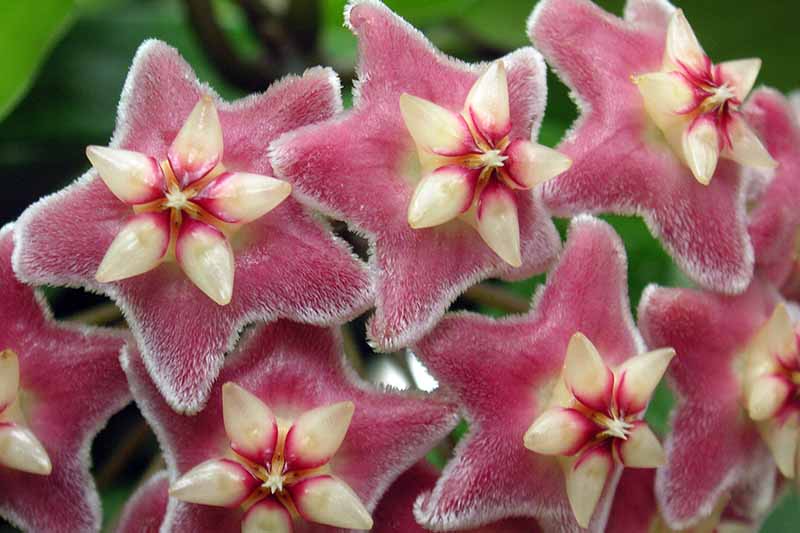
If you’re wondering if this hoya will work in a home where pets reside, the ASPCA lists H. pubicalyx as nontoxic to cats.
All varieties of this species prefer bright indirect light and higher humidity – at least 60 percent. This type is easy to grow, making it a good starter hoya.

H. Publicalyx ‘Splash’ Live Plant in 4” Pot
Do splashy foliage, fuzzy blooms, and easy care sound fantastic to you? You’ll find H. pubicalyx ‘Splash’ in a four-inch pot from California Tropicals via Amazon.
25. Sumatra
‘Sumatra’ is a cultivar of H. caudata, a native of Thailand, Malaysia, Indonesia, and Singapore, where it grows on trees or rocks.
This is a hoya that proves that old saying, beauty is in the eye of the beholder.
The leaves of H. caudata are elliptical, have a dull sheen, and are olive green and brownish, mottled with grey.
They can be quite large, up to six inches long by nearly three inches wide, and have slightly wavy margins, which make them look like they’ve been roughed up a bit.
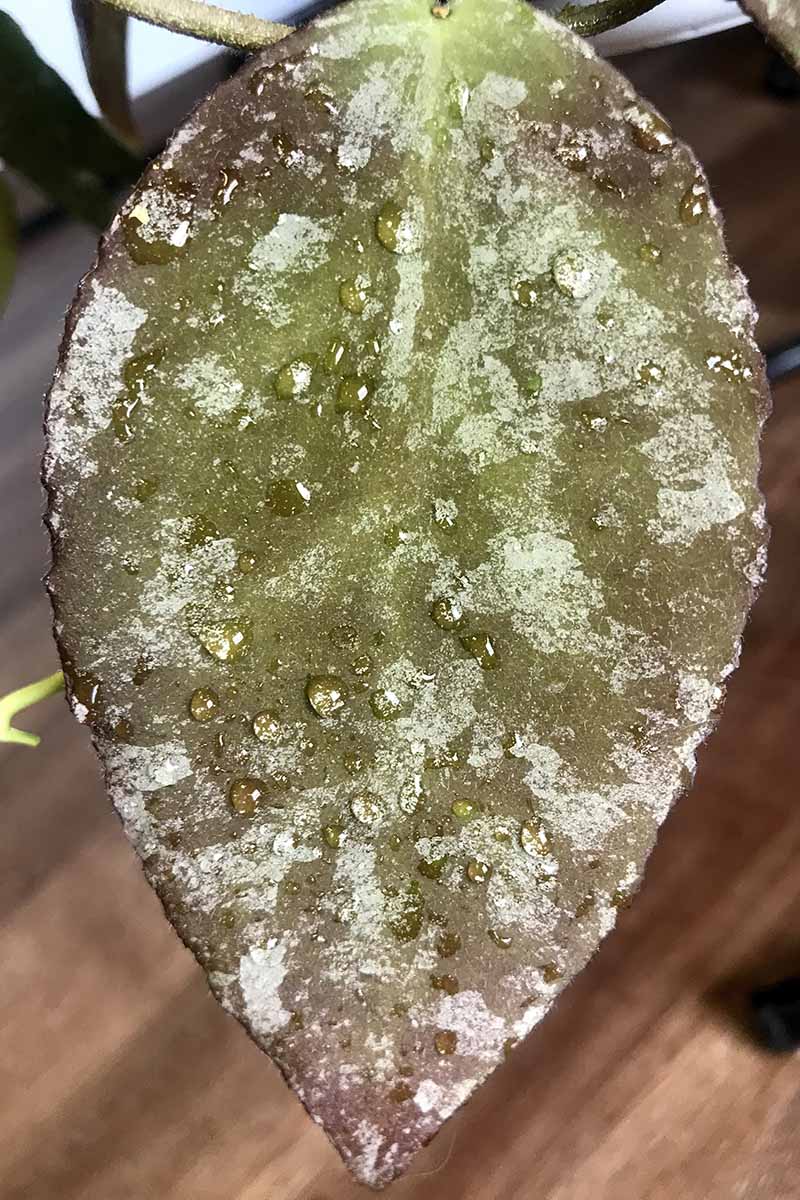
Some may find this species to be gorgeous, while others may not! Perhaps this is one of those species that will appeal most to collectors looking for the thrill of owning a new type of hoya.
The foliage of ‘Sumatra’ is redder than that of the natural species, and with brighter light, the foliage turns a darker, purplish hue.
The flowers are delicately hairy, and white to pale pink with purple centers. With a vanilla fragrance, they last for a few days. The vines can grow to 10 feet or longer.
H. caudata ‘Sumatra’ requires more moist conditions than many other hoyas and it shouldn’t be allowed to dry out between waterings. Keep its soil moist but well-draining. Smaller specimens can be kept in terrariums.
26. Sunrise
Known and loved for its beautifully colored foliage when exposed to bright light, ‘Sunrise’ is an interspecies cross between H. lacunosa var. pallidiflora and H. obscura.
It has medium-sized, elliptical leaves that take on a reddish hue when provided with some direct sunlight – a technique called “sun stressing.” When the foliage is red, this hybrid cultivar’s contrasting light green veins become very apparent.
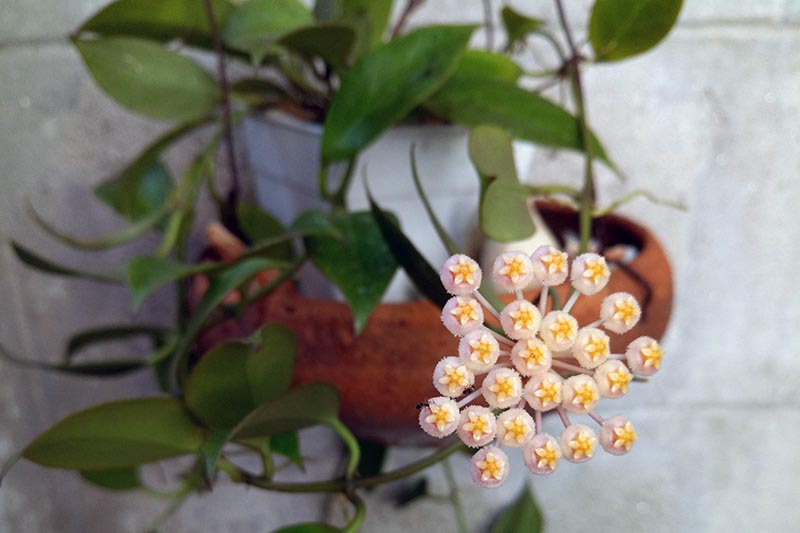
‘Sunrise’ produces vines that grow to be six to eight feet long or more, bearing creamy white to pink flowers with yellow centers that are intensely fragrant.
This hoya can be a bit tricky to get settled in, but once it acclimates, it will take off.

‘Sunrise’ Live Plant in 6” Pot
If you want ‘Sunrise’ to give you a cheery greeting first thing every morning, you’ll find a live plant in a six-inch pot from the Plant Farm Store via Amazon.
27. Tricolor
Another variety of H. carnosa, ‘Tricolor’ is very similar to ‘Rubra’ but with reversed variegation.
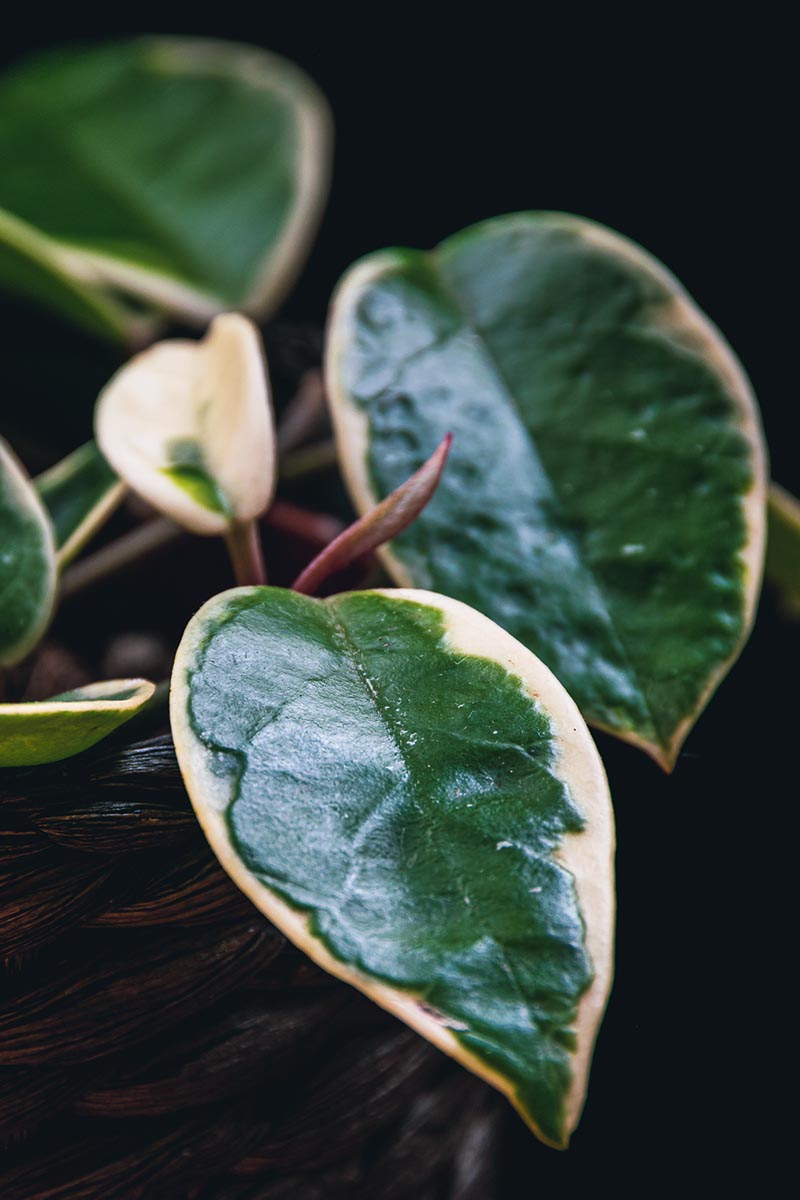
This cultivar’s elliptical leaves have creamy margins with green centers, and new foliage and vines that are bright pink. It’s also known as ‘Krimson Queen.’
The vines grow six feet long or more and produce large, showy umbels with red-centered pink flowers.
H. Carnosa ‘Tricolor’ Live Plant in 4” Pot
Do you love the subtle variegation and bright pinks of ‘Tricolor’? You’ll find a live specimen in a four-inch pot available from Hirt’s Garden Store via Amazon.
28. Variegata
Here’s another hoya that has both fabulous texture and attractive coloring.
‘Variegata’ is often referred to on plant labels as a cultivated variety of H. latifolia, a species native to Borneo, Java, Malaysia, Myanmar, Sumatra, and Thailand.
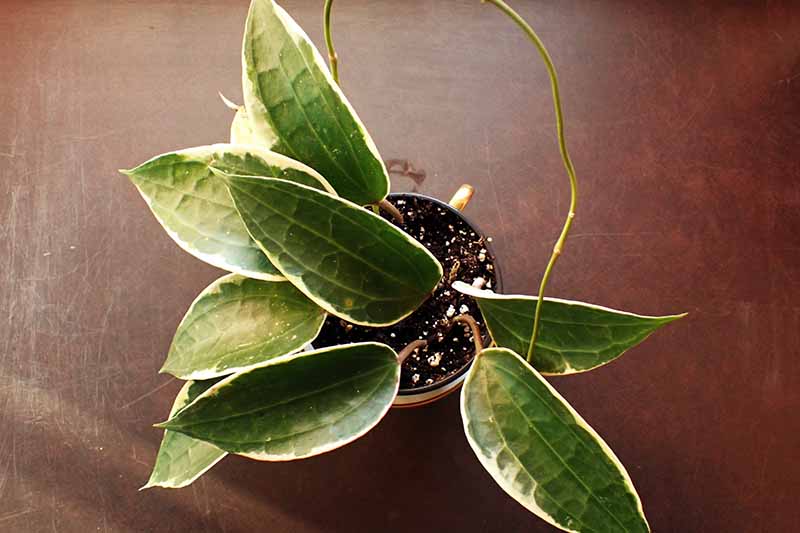
Also known as H. latifolia var. albomarginata, indicating that it was in fact found in the wild, and formerly classified as H. macrophylla, the foliage of this hoya is medium green with prominent raised veins, and variegated margins in yellow or cream. The edges of the thick leaves often show purplish-red coloration.
This hoya produces vines that reach six feet long or more, and fragrant flowers that are creamy white tinged with pink. These bloom in late summer to early fall, and last for several days.

H. Latifolia (Macrophylla) Albomarginata Live Plant in 2” Pot
Be careful if you decide to bring ‘Variegata’ into your home – you might find yourself utterly distracted, popping out of your chair to go and gaze at this lovely hoya.
You’ll find a live specimen in a two-inch pot from the Plant Farm Store via Amazon.
29. Wayetii
We’ve arrived at the last hoya destination on our tour today, a hoya that has all the best qualities of these houseplants – mounds of thick foliage, fragrant flowers, and a little touch of the unusual.
H. wayetii is a native of the Philippines. Its thick, medium-green leaves are canoe-shaped, measuring three and a half inches long and three-quarters of an inch wide. They have dark green edges.
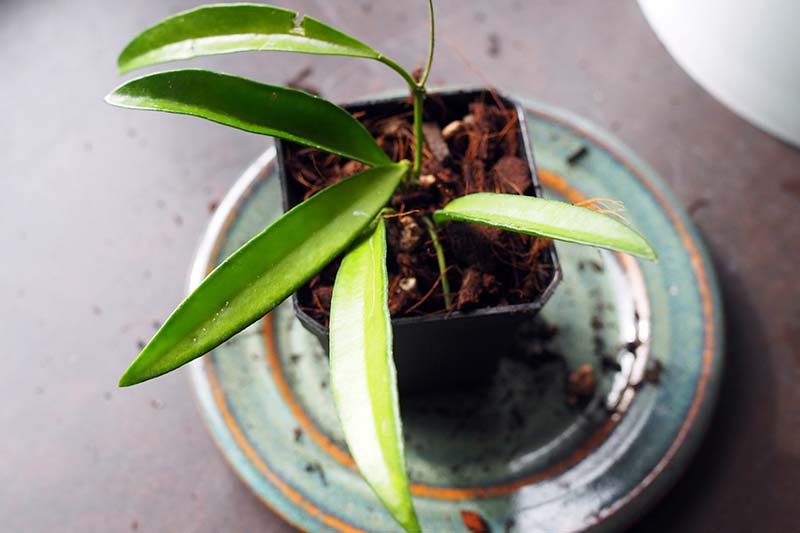
When exposed to bright light, these dark green edges can turn maroon. Some specimens produce young leaves that have a reddish-orange tint.
The flowers of H. wayetii are mauve with purple centers, fragrant, and velvety. Sometimes the coronas have yellow tips.
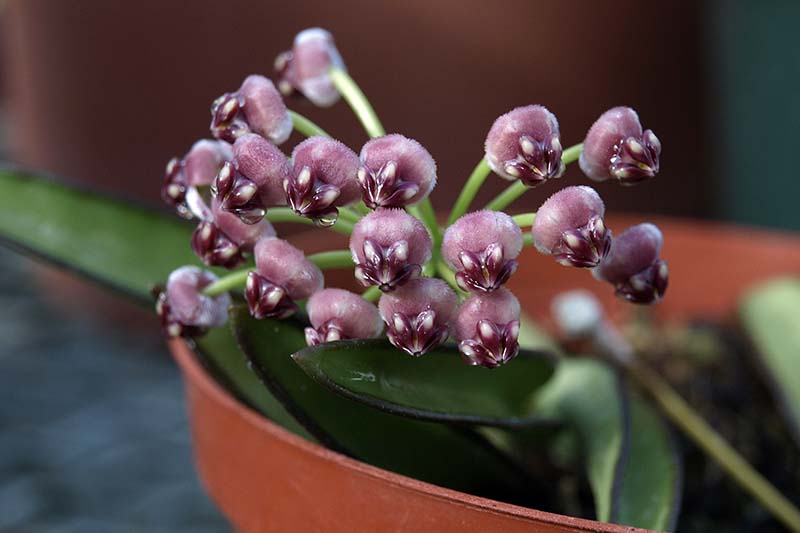
Though it is easily confused with H. kentiana, there are two easy ways to differentiate these species: the flowers of H. wayetii are held in a tighter bunch, and its leaves are shorter.
This species is fairly compact, with vines reaching just two and a half to three feet long.
H. Wayetii Live Plant in 2” Pot
You may not have room for a canoe in your living room, but perhaps you can make space for some canoe-shaped leaves – and rest assured, they will take you places!
You can purchase H. wayetii in a six-inch pot from the BubbleBlooms store via Amazon.
Up to the Eaves in Leaves
With all these gorgeous vines, it’s hard not to want to fill up your entire home with one of each of these incredible varieties.
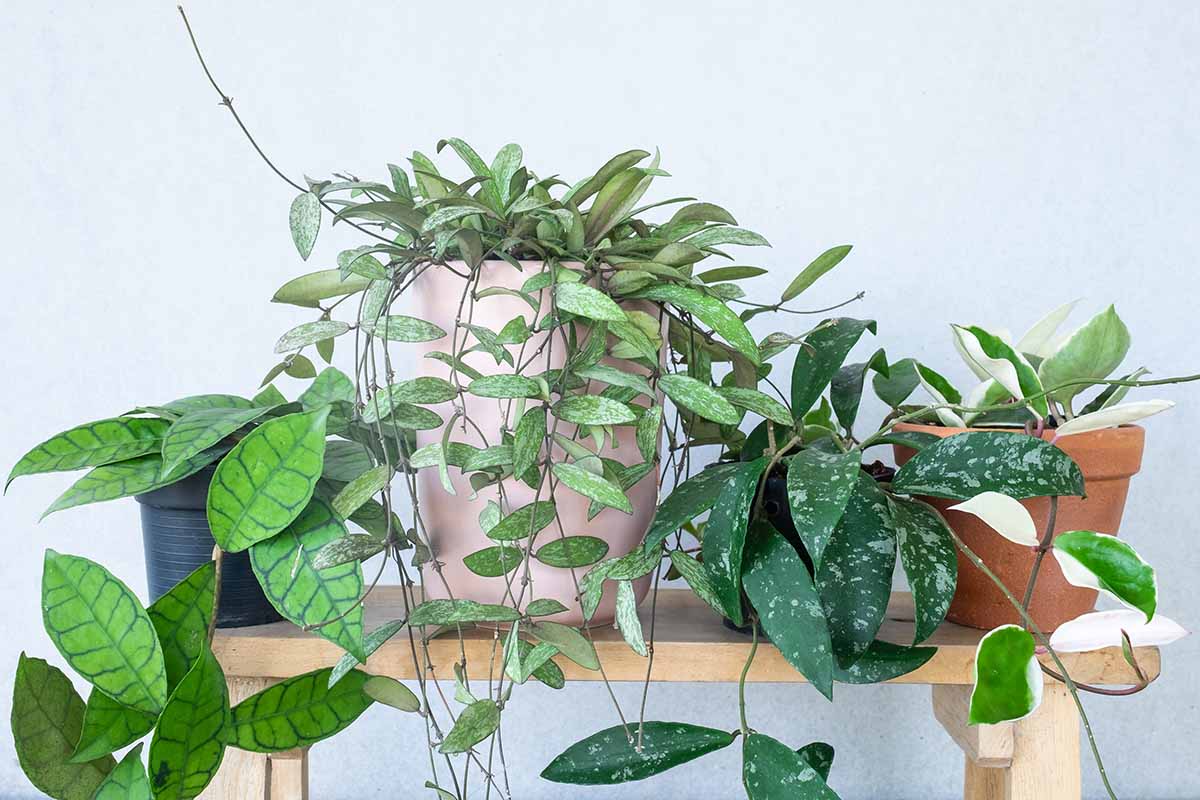
Do you have any favorites that weren’t mentioned here? And what do you think about the weird and wonderful H. caudata ‘Sumatra’?
Be sure to let us know! And if you’re trying to identify a species or cultivar and can’t quite figure it out, feel free to share your photos in the comments section below and we’ll try to give you a hand.
If you’re interested in choosing some buddies for your hoyas, why not keep digging into your houseplant reading right here, starting with these articles?
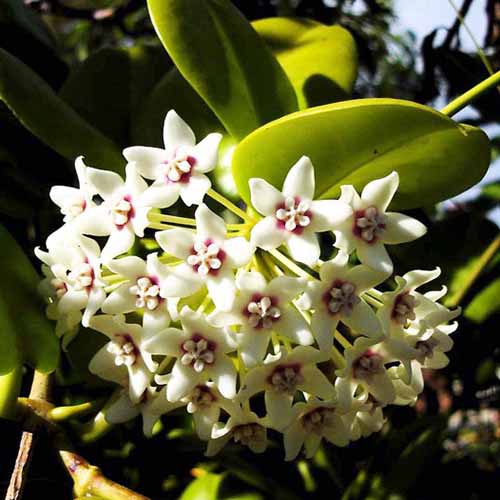
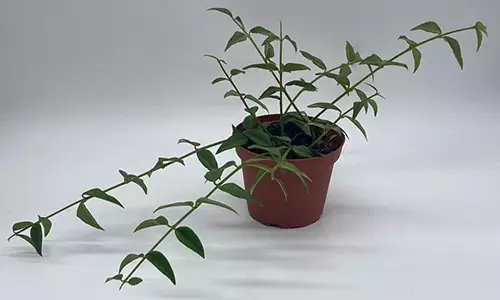
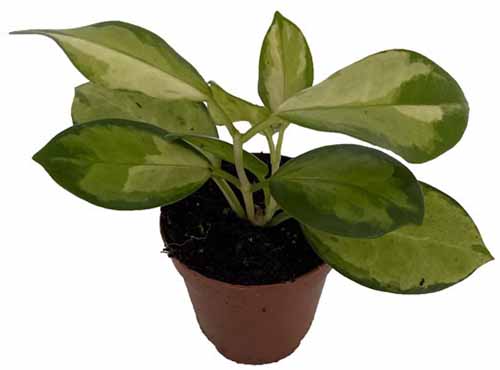
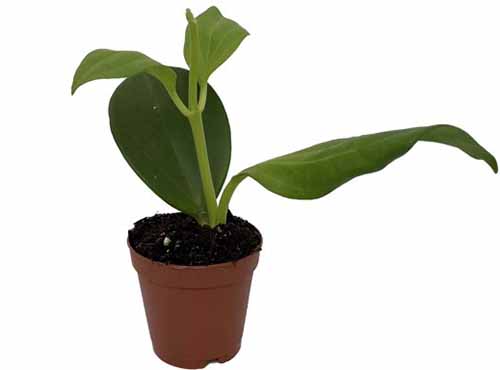
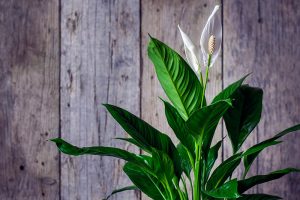
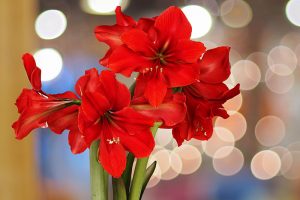
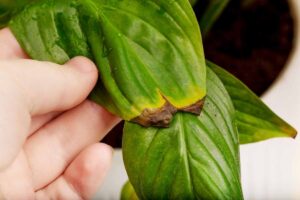
I love Hoyas. I got my first slip from my mother in law 40 years ago, Matilda is the one. My daughter now has a slip also and it’s huge and it’s blooming all the time. I have one I’m pretty sure is a Hoya but the leaves are curly. I am going to try to send you a picture with it and let me know if I’m right and what kind of hoya it is.
Hi Lise, your pictures didn’t post correctly, so I’ve attached them here 🙂
It’s a H. Compact, also known as the “rope”… I too have one
Hi Lise,
Hoya ‘Mathilde’ is a very pretty hoya! I love its splashed leaves.
As for the other one, thanks for sharing your photos, yes, that is definitely a hoya! That one is known as “Hindu rope” – it’s a cultivar of Hoya carnosa. You can read more about that particular type in our guide to growing and caring for hoyas.
Happy hoya growing!
I have four Hoyas all of which I believe are the species. My question is how long do these take to start producing blooms. Mine are at least 2 years old and have not bloomed. These were given to me by a friend who indicated they would bloom within the first year. Most of these were well rooted and about 16-18” in diameter with vines about 3’ long. Thank you!
Hi Sandra,
Thanks for your question. I’m not quite sure which species you are referring to – if you aren’t sure of the identity of your plants, feel free to post some photos here and I can help you ID them! As for your question on flowering, this will vary from type to type. However there are many things you can do to encourage blooms on your plants – I recommend you read the section on encouraging flowering in our complete guide on how to grow hoyas.
Hope this helps!
I am trying to identify this type of Hoya. Can you help?
Hi Linda,
I’d love to help! Did you try posting a photo? If you did and it’s not showing up, I’ll ask our editors to see if they can retrieve it.
If you haven’t yet tried to post a photo, you can do so by clicking the paperclip icon in the bottom right hand corner of the comment box.
Thanks!
I’ve managed to retrieve the picture, here it is:
Hi Linda,
Luckily one of our editors was able to retrieve your photo so that I could take a glance at your plant. That’s actually not a hoya after all, but is a type of peperomia. (We have a growing guide dedicated to caring for peperomias, in case you need any tips!)
I believe this is Peperomia quadrangulis (also known as P. angulata) – you can read about it in our article on different types of peperomias.
Hope this helps!
Can you help me identify this plant, I’m pretty sure it is a type of Hoya but not sure which kind. I’ve taken a cutting from a plant a coworker had at the office, who has passed away, and I’m not sure if the red on the back indicates that it is sick or if it is a different species from what I currently have or been able to find online.
Hi Nicole, I have attached your pictures here. Kristina will be along to take a look.
Hi Nicole,
Thanks for sharing your photos.
I am editing my response to you after one of our other writers, Rose Kennedy, ID’d your plant. She recognized it as “black pagoda lipstick plant” (Aeschynanthus longicaulis). It’s also known as “zebra basket vine.”
We don’t have a growing guide for this houseplant yet, but it looks like the care conditions are fairly similar to care for hoyas.
Red coloration on the foliage of this plant is normal, so you don’t have anything to worry about there!
Enjoy your black pagoda lipstick plant!
Hi Nicole,
Just in case you don’t get an update of my edited response, one of our other writers was able to find the true ID of this plant – black pagoda lipstick plant. It looks very much like it could be a hoya, though, so the mix up was very understandable!
Hope this helps!
Hello, I noticed you called the Krohniana “Eskimo” but that is a derogatory term that is widely not accepted in the plant community. I am requesting that you please edit and update to the proper name that is Krohniana Super Silver. Thanks so much. 🙂
Hi Taylor,
Thanks for pointing this out, it is definitely our policy to avoid terms that people find offensive.
After looking into the matter, I believe that ‘Eskimo’ is alternately called ‘Silver,’ and that actually, ‘Super Silver’ is a variant of that one, with much lighter colored leaves that are almost solid silver.
We’ll certainly make a note to change the name when the article gets updated, with a mention of the alternate name, ‘Eskimo.’
Thanks!
Hello everyone in here.
I am very new to this hobby. Started last year and have collected some rare philodendrons, anthurium, aglaonema, alocasia and calethea which I can recognize without doubt. But this hoya is giving me hard time to name.
Can anyone name this hoya for me please.
It definitely have the looks of a latifolia. But whenever I try to search from google, I cant find the exact resemblance to other latifolia photos because mine has a very dark lining on the edges and it’s big
Sorry for my english. Thank you from Japan
Hi Aki, Thanks for posting your question and photo here. And your English is great! I think you were correct with your ID of Hoya latifolia – also known as Hoya macrophylla – that last word means “big leaf” – so yes, this species is known for its large leaves. There are a few different cultivars of this species. One of them, ‘Variegata,’ has light colored margins. There’s another one with very, very large leaves called ‘Dinner Plate.’ And there’s another called ‘Sarawak’ which has heart shaped leaves. To me, yours looks like the straight species, H. latifolia – sometimes… Read more »
I was told this was a Hoya Bush. Please identify and give me advice on caring for it.
It looks like a Hoya Cumingiana, i just bought one myself 🙂
Thanks Jenni, hope you are enjoying your H. cumingiana! I have not yet added one of them to my collection, but it’s on my wishlist.
Hi Lisa,
I agree with our reader Jenni, who identified this as a Hoya cumingiana. This type of hoya is easy to care for and a fast grower. You can learn more about caring for hoyas with our complete guide, right here.
Hope this helps!